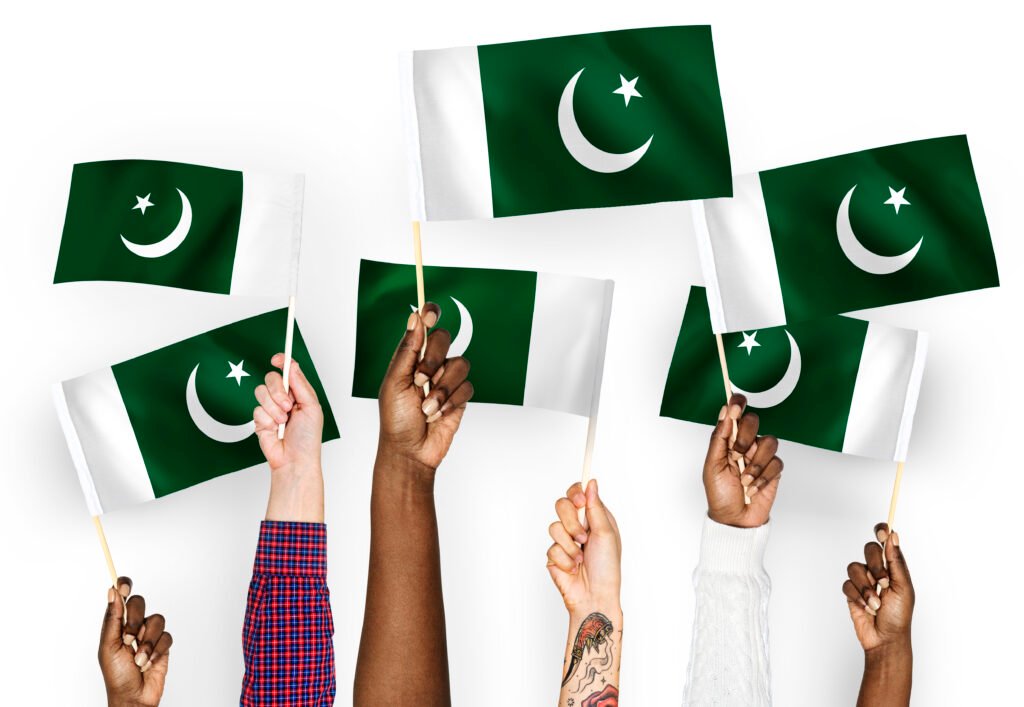
Table of Contents
ToggleEid-ul-Fitr:
The first famous Festival of Pakistan is “Eid-ul-Fitr” Eid-ul-Fitris a joyful holiday celebrated by Muslims all around the world. It comes right after Ramadan, which is a month of fasting from dawn to sunset. Here are some simple points about Eid-ul-Fitr:
Prayers:
On the morning of Eid, Muslims gather in large groups to pray together. This special prayer is called the Eid prayer. It usually takes place in big open spaces or large mosques. Everyone wears their best clothes and greets each other with “Eid Mubarak,” which means “Blessed Eid.”
Feasts:
After the prayers, families and friends come together to enjoy delicious meals. The food is often very special and includes a variety of traditional dishes and sweets. It’s a time for everyone to eat and celebrate together. Some popular dishes might include biryani, kebabs, and sweet treats like sheer khurma.
Charity:
- One important part of Eid-ul-Fitr is giving to those in need. This is called Zakat al-Fitr. Before the Eid prayer, Muslims give money or food to the poor so that everyone can join in the celebrations. This act of charity ensures that even those who are less fortunate can have a happy Eid.
- Celebrations: The rest of the day is filled with visiting friends and family, exchanging gifts, and enjoying the festive atmosphere. Children often receive new clothes, toys, and money as gifts. Homes are decorated, and there is a lot of joy and laughter
Eid-ul-Fitr is a time of happiness, gratitude, and community. It’s a chance for Muslims to come together, celebrate the end of Ramadan, and share their blessings with others. Do you have any special traditions or memories from Eid-ul-Fitr that you cherish?
Eid-ul-Adha:
Eid-ul-Adha is a significant holiday for Muslims, celebrated worldwide. It commemorates the willingness of Prophet Ibrahim (Abraham) to sacrifice his son as an act of obedience to God. Here are some simple points about Eid-ul-Adha:
Story of Sacrifice:
- Eid-ul-Adha remembers the story of Prophet Ibrahim, who was ready to sacrifice his son, Ismail, to show his faith in God. At the last moment, God provided a ram to sacrifice instead. This story is a reminder of faith and obedience.
- Animal Sacrifice: One of the main rituals of Eid-ul-Adha is the sacrifice of an animal, usually a goat, sheep, cow, or camel. This act is called Qurbani. The meat from the sacrificed animal is divided into three parts: one part for the family, one part for friends and relatives, and one part for those in need. This ensures that everyone can share in the celebration.
Prayers and Feasts:
- Like Eid-ul-Fitr, the day starts with a special prayer called the Eid prayer. People dress in their best clothes and gather in large groups to pray.
After the prayer: Families and friends come together to enjoy festive meals. The food often includes dishes made from the sacrificed animal, along with other traditional foods.
- Charity and Community: Giving to those in need is an important part of Eid-ul-Adha. By sharing the meat and providing for the less fortunate, Muslims show compassion and solidarity with their community.
- Celebrations: The rest of the day is filled with visiting friends and family, exchanging gifts, and enjoying the festive atmosphere. Homes are decorated, and there is a lot of joy and laughter.
Eid-ul-Adha is a time of reflection, gratitude, and community. It’s a chance for Muslims to remember the importance of faith and to share their blessings with others. Do you have any special traditions or memories from Eid-ul-Adha that you cherish?
Basant Festival:

Basant Festival is a vibrant celebration marking the arrival of spring, particularly famous in Lahore, Pakistan. Known primarily for its kite-flying tradition, the festival fills the skies with colorful kites as families and friends gather on rooftops to compete in friendly duels. The festival is not only about kite flying but also about the renewal and joy that spring brings, symbolized by the bright yellow attire worn by participants, reflecting the blooming mustard fields. Although it has faced some restrictions due to safety concerns, Basant remains a significant cultural event, representing joy, community, and the celebration of life in Pakistan.
Season and Timing:
- Celebrated in spring, typically in February.
- Main Location: Lahore is the epicenter of the festival.
- Core Activity: Known for kite flying; the sky is filled with colorful kites.
- Cultural Significance: Marks the arrival of spring, symbolizing renewal and rejuvenation.
- Social Gathering: Families and friends gather on rooftops to fly kites and compete in friendly duels.
- Traditional Expression: The phrase “Bo Kata!” is commonly shouted when a kite is cut.
- Attire and Symbolism: People wear bright yellow outfits, representing spring and mustard fields.
- Festival Atmosphere: Includes traditional music, dance, and feasting.
- Lahore’s Role: The city’s skyline becomes a spectacular sight during the festival.
- Safety Concerns: The festival has faced restrictions due to accidents and environmental issues.
- Symbolism: Basant represents joy, community, and the celebration of life in Pakistani culture.
Independence Day (14th August):
Independence Day on 14th August is a significant national holiday in Pakistan, marking the country’s independence from British rule in 1947. The day is celebrated with great enthusiasm and patriotism across the nation. Streets and buildings are adorned with the national flag, and a variety of events take place, including parades, fireworks, and cultural performances. The celebrations reflect the pride and unity of the Pakistani people as they honor the sacrifices made for their freedom and reaffirm their commitment to the nation’s progress.
- Celebrated annually on 14th August.
- Commemorates Pakistan’s independence from British rule in 1947.
- National flag hoisting ceremonies take place across the country.
- Parades and military displays are held, particularly in the capital, Islamabad.
- Fireworks and patriotic songs are a staple of the celebrations.
- Speeches by national leaders highlight the significance of independence.
- The day fosters a sense of pride, unity, and patriotism among Pakistanis.
Pakistan Day (23rd March):
Pakistan Day, observed on 23rd March, is a national holiday in Pakistan that commemorates the Lahore Resolution of 1940, a landmark event in the country’s history. The Lahore Resolution, passed during the All India Muslim League’s session, laid the foundation for the creation of Pakistan. It called for the establishment of an independent state for Muslims in the north-western and eastern zones of India, leading to the birth of Pakistan seven years later in 1947.
- 1.The day typically begins with a 31-gun salute in Islamabad and 21-gun salutes in provincial capitals, followed by a military parade showcasing the armed forces’ strength and capabilities.
- 2.Various ceremonies and events are organized nationwide, with government buildings and public spaces decorated with lights and flags to honor the leaders of the Pakistan Movement and inspire unity among citizens.
Mela Chiraghan (Festival of Lights):
Mela Chiraghan, also known as the Festival of Lights, is a vibrant and spiritually significant event held annually in Lahore to honor the revered Sufi saint, Shah Hussain. This festival, which translates to “Festival of Lights,” is celebrated with great enthusiasm and devotion, drawing thousands of devotees and visitors from across the region. The heart of the celebration involves the lighting of countless oil lamps, creating a mesmerizing and serene atmosphere that symbolizes the light of spirituality and the teachings of Shah Hussain.
Key Highlights of Mela Chiraghan:
- Lighting of Oil Lamps: The main attraction is the lighting of numerous oil lamps, creating a beautiful and peaceful scene.
- Traditional Music and Dance: Qawwali and other forms of Sufi music fill the air, invoking a sense of divine connection and communal harmony.
- Gatherings at Shah Hussain’s Shrine: Devotees gather around the shrine to pay their respects and seek blessings.
- Colorful Decorations: Streets and homes are adorned with vibrant decorations.
- Traditional Foods and Sweets: The aroma of special foods and sweets fills the air, adding to the festive spirit.
- Vendor Stalls: Stalls selling religious artifacts and local delicacies contribute to the lively atmosphere.
Mela Chiraghan is a profound expression of Lahore’s rich cultural heritage and its deep-rooted Sufi traditions. It serves as a reminder of the enduring legacy of Shah Hussain and his message of love, peace, and spiritual enlightenment. The festival not only honors the saint but also brings together people from diverse backgrounds, fostering a sense of unity and shared cultural identity.
Shandur Polo Festival:
The Shandur Polo Festival is a remarkable event held at the highest polo ground in the world, Shandur Pass. This unique festival is a blend of thrilling polo matches and vibrant cultural activities, drawing visitors from across the globe to witness the sport and immerse themselves in the rich cultural heritage of the region.
Key Highlights of Shandur Polo Festival:
- Highest Polo Ground: The festival takes place at Shandur Pass, which is renowned as the highest polo ground in the world. This adds a unique and adventurous element to the event.
- Traditional Polo Matches: The main attraction of the festival is the exhilarating polo matches between teams from Chitral and Gilgit. These matches are played in their traditional form, showcasing the skill and passion of the players.
- Cultural Events: Alongside the polo matches, the festival features a variety of cultural events. Traditional music and dance performances, as well as local crafts exhibitions, provide a glimpse into the rich cultural tapestry of the region.
- Scenic Beauty: The stunning landscape of Shandur Pass enhances the charm of the festival. The breathtaking views of the surrounding mountains and valleys create a picturesque backdrop for the event.
- Community Gathering: The festival is a significant community event, bringing together people from different regions. It fosters a sense of unity and celebration, as participants and spectators come together to enjoy the festivities.
- Local Cuisine: Visitors have the opportunity to savor a variety of traditional foods and delicacies. The local cuisine adds to the overall experience, offering a taste of the region’s culinary heritage.
The Shandur Polo Festival is more than just a sporting event; it is a celebration of sport, culture, and community. It highlights the rich traditions of the region and provides a unique opportunity for visitors to experience the beauty and heritage of northern Pakistan. The festival not only showcases the thrilling sport of polo but also promotes cultural exchange and unity among the participants and spectators.
Lal Shahbaz Qalandar Urs:
The Lal Shahbaz Qalandar Urs is a vibrant and spiritually enriching festival held in Sehwan Sharif to honor the revered Sufi saint, Lal Shahbaz Qalandar. This annual event is a blend of music, dance, and spiritual gatherings, attracting devotees and visitors from all over the world.
Key Highlights of Lal Shahbaz Qalandar Urs:
- Celebration of a Sufi Saint: The festival commemorates the life and teachings of Lal Shahbaz Qalandar, a prominent Sufi saint known for his message of love, peace, and unity. His shrine in Sehwan Sharif becomes the focal point of the celebrations.
- Spiritual Gatherings: The Urs features numerous spiritual gatherings where devotees engage in prayers, recitations of Sufi poetry, and discussions on the saint’s teachings. These gatherings provide a profound spiritual experience for participants.
- Music and Dance: Traditional Sufi music and dance are integral parts of the festival. The rhythmic beats of the dhol (drum) and the soulful melodies of qawwali (Sufi devotional music) create an atmosphere of devotion and joy. The dhamal, a form of ecstatic dance, is performed by devotees as an expression of their spiritual fervor.
- Cultural Events: Alongside the spiritual activities, the festival includes various cultural events. These events showcase the rich cultural heritage of the region, with performances by local artists and exhibitions of traditional crafts.
- Community Gathering: The Urs is a significant community event, bringing together people from different backgrounds. It fosters a sense of unity and brotherhood, as participants come together to celebrate the saint’s legacy.
- Local Cuisine: Visitors can enjoy a variety of traditional foods and delicacies during the festival. The local cuisine adds to the overall experience, offering a taste of the region’s culinary traditions.
The Lal Shahbaz Qalandar Urs is more than just a festival; it is a celebration of spirituality, culture, and community. It highlights the enduring legacy of Lal Shahbaz Qalandar and provides a unique opportunity for visitors to experience the spiritual and cultural richness of Sehwan Sharif. The festival not only honors the saint but also promotes a message of love, peace, and unity among all who attend.
Ashura:
Ashura is a significant day observed on the 10th day of Muharram, the first month of the Islamic calendar. This solemn occasion commemorates the martyrdom of Imam Hussain, the grandson of Prophet Muhammad, and holds deep religious and historical significance for Muslims around the world.
Key Highlights of Ashura:
- Historical Significance: Ashura marks the tragic event of the Battle of Karbala, where Imam Hussain and his companions were martyred in 680 AD. This event is a pivotal moment in Islamic history, symbolizing the struggle against tyranny and injustice.
- Commemoration of Imam Hussain: The day is dedicated to remembering the sacrifice of Imam Hussain and his followers. Their unwavering stand for truth and justice is honored through various religious activities and rituals.
- Religious Observances: On Ashura, Muslims engage in prayers, fasting, and recitations of the Quran. Many also participate in processions and gatherings where the story of Karbala is recounted, and sermons are delivered to reflect on the lessons of the event.
- Mourning Rituals: In many communities, mourning rituals such as chest-beating (matam) and reenactments of the Battle of Karbala are performed. These acts of mourning express the deep sorrow and reverence for the martyrs of Karbala.
- Charitable Acts: Ashura is also a time for acts of charity and kindness. Many people distribute food and water to the needy, reflecting the values of compassion and generosity exemplified by Imam Hussain.
- Community Gathering: The observance of Ashura brings together people from different backgrounds, fostering a sense of unity and solidarity. It is a time for communal reflection and reaffirmation of shared values.
Ashura is more than just a day of mourning; it is a profound reminder of the principles of justice, sacrifice, and resilience. It provides an opportunity for Muslims to reflect on the legacy of Imam Hussain and to draw inspiration from his unwavering commitment to truth and righteousness. The observance of Ashura not only honors the memory of the martyrs of Karbala but also reinforces the values of faith, compassion, and unity among the Muslim community.
Chehlum:
Chehlum, also known as Arbaeen, is observed on the 40th day after Ashura. This significant day commemorates the martyrdom of Imam Hussain and his companions, continuing the mourning period that began on Ashura. It is a time of deep reflection and remembrance for Muslims around the world.
Key Highlights of Chehlum:
- 40th Day After Ashura: Chehlum marks the 40th day following the tragic events of Ashura. This period of mourning culminates in a day of solemn observance, honoring the sacrifices made by Imam Hussain and his followers.
- Commemoration of Martyrs: The day is dedicated to remembering the martyrs of Karbala. Their courage and steadfastness in the face of oppression are honored through various religious and cultural activities.
- Processions: One of the central features of Chehlum is the processions that take place in many cities. Devotees walk in large groups, often covering long distances, to express their grief and solidarity with the martyrs of Karbala. These processions are a powerful display of communal mourning and devotion.
- Mourning Rituals: Similar to Ashura, Chehlum involves mourning rituals such as chest-beating (matam) and recitations of elegies (marsiyas) that recount the events of Karbala. These rituals serve as a means for participants to express their sorrow and reverence.
- Religious Observances: On Chehlum, Muslims engage in prayers, Quran recitations, and sermons that reflect on the lessons of Karbala. These religious observances provide an opportunity for spiritual reflection and reaffirmation of faith.
- Community Gathering: Chehlum brings together people from various backgrounds, fostering a sense of unity and collective remembrance. It is a time for communal reflection and support, as participants come together to honor the legacy of Imam Hussain.
Chehlum is more than just a continuation of the mourning period; it is a profound reminder of the principles of justice, sacrifice, and resilience. It provides an opportunity for Muslims to reflect on the enduring legacy of Imam Hussain and to draw inspiration from his unwavering commitment to truth and righteousness. The observance of Chehlum not only honors the memory of the martyrs of Karbala but also reinforces the values of faith, compassion, and unity within the Muslim community.
Kalash Festivals:
Kalash Festivals are vibrant and culturally rich celebrations held by the Kalash people in the Chitral Valley of Pakistan. These festivals, including Chilam Joshi and Uchal, are a testament to the unique traditions and heritage of the Kalash community, attracting visitors from around the world.
Key Highlights of Kalash Festivals:
- Celebration by the Kalash People: The Kalash people, known for their distinct culture and traditions, celebrate these festivals with great enthusiasm. The festivals are an integral part of their cultural identity and heritage.
- Chilam Joshi (Spring Festival): Chilam Joshi, also known as the spring festival, marks the arrival of spring. It is celebrated with traditional music, dance, and rituals. The festival is a time of joy and renewal, as the Kalash people welcome the new season with open hearts.
- Uchal (Harvest Festival): Uchal is the harvest festival, celebrated to thank the gods for a bountiful harvest. It involves various rituals, including offerings of the first fruits of the harvest. The festival is characterized by traditional dances, music, and feasting, reflecting the gratitude and joy of the community.
- Traditional Music and Dance: Both Chilam Joshi and Uchal feature traditional Kalash music and dance. The rhythmic beats of drums and the melodies of flutes create a festive atmosphere, while the dances, performed in colorful traditional attire, showcase the cultural richness of the Kalash people.
- Cultural Events: Alongside the main festivities, various cultural events take place, including storytelling, craft exhibitions, and traditional games. These events provide a deeper insight into the Kalash way of life and their rich cultural heritage.
- Scenic Beauty: The stunning landscape of the Chitral Valley adds to the charm of the festivals. The picturesque surroundings of mountains and valleys create a beautiful backdrop for the celebrations.
- Community Gathering: The festivals bring together the Kalash community and visitors, fostering a sense of unity and celebration. It is a time for communal bonding and sharing of cultural traditions.
Kalash Festivals are more than just celebrations; they are a vibrant expression of the Kalash culture and heritage. They provide a unique opportunity for visitors to experience the rich traditions and hospitality of the Kalash people. The festivals not only highlight the cultural diversity of Pakistan but also promote a message of unity and harmony among different communities.
Youm-e-Ali:
Youm-e-Ali is a significant day in the Islamic calendar, commemorating the martyrdom of Hazrat Ali, the cousin and son-in-law of Prophet Muhammad (PBUH). This day is observed with deep reverence and solemnity by Muslims around the world, particularly in Pakistan.
Key Highlights of Youm-e-Ali:
- Commemoration of Hazrat Ali’s Martyrdom: Youm-e-Ali marks the anniversary of the martyrdom of Hazrat Ali, who was assassinated in the Grand Mosque of Kufa. His life and teachings are remembered and honored on this day.
- Processions and Gatherings: The day is observed with processions and religious gatherings. Devotees participate in processions, reciting elegies and paying homage to Hazrat Ali. These processions are a significant aspect of the observance, symbolizing the collective mourning and respect for Hazrat Ali.
- Majlis and Sermons: Religious scholars and leaders deliver sermons and hold majlis (gatherings) to recount the life, virtues, and sacrifices of Hazrat Ali. These sessions provide an opportunity for reflection and spiritual growth.
- Charity and Acts of Kindness: Many people engage in acts of charity and kindness on Youm-e-Ali, following the example set by Hazrat Ali, who was known for his compassion and generosity. Distributing food and providing assistance to the needy are common practices.
- Recitation of Quran and Prayers: Special prayers and recitations of the Quran are conducted in mosques and homes. These prayers seek blessings and peace for the soul of Hazrat Ali and for the well-being of the community.
- Cultural Significance: Youm-e-Ali holds cultural significance as well, with various cultural events and activities organized to honor the legacy of Hazrat Ali. These events often include poetry recitations, plays, and exhibitions that highlight his contributions to Islamic thought and philosophy.
- Unity and Solidarity: The observance of Youm-e-Ali fosters a sense of unity and solidarity among Muslims. It is a time for communal bonding and reaffirming the values of justice, courage, and piety that Hazrat Ali exemplified.
Youm-e-Ali is more than just a day of mourning; it is a day of reflection, learning, and spiritual renewal. It provides an opportunity for Muslims to come together, honor the legacy of Hazrat Ali, and draw inspiration from his life and teachings. The observance of Youm-e-Ali not only strengthens the faith of individuals but also promotes a message of unity and harmony within the community.
Eid Milad-un-Nabi:
Eid Milad-un-Nabi, also known as Mawlid al-Nabi, is a significant Islamic festival that commemorates the birth of Prophet Muhammad (PBUH). This day is celebrated with great reverence and joy by Muslims around the world, particularly in Pakistan.
Key Highlights of Eid Milad-un-Nabi:
- Celebration of the Prophet’s Birth: Eid Milad-un-Nabi marks the birth of Prophet Muhammad (PBUH), who is regarded as the last prophet in Islam. His life and teachings are celebrated and remembered on this auspicious day.
- Processions and Gatherings: The day is marked by vibrant processions and gatherings. Devotees participate in processions, reciting naats (poetry in praise of the Prophet) and carrying banners. These processions are a significant aspect of the celebration, symbolizing the joy and reverence for the Prophet.
- Special Prayers and Recitations: Mosques and homes are adorned with lights and decorations. Special prayers and recitations of the Quran are conducted to seek blessings and peace. These prayers are an integral part of the observance, reflecting the spiritual significance of the day.
- Religious Events and Sermons: Religious scholars and leaders deliver sermons and hold gatherings to recount the life, virtues, and teachings of Prophet Muhammad (PBUH). These sessions provide an opportunity for reflection and spiritual growth.
- Charity and Acts of Kindness: Many people engage in acts of charity and kindness on Eid Milad-un-Nabi, following the example set by the Prophet, who was known for his compassion and generosity. Distributing food and providing assistance to the needy are common practices.
- Cultural Significance: Eid Milad-un-Nabi holds cultural significance as well, with various cultural events and activities organized to honor the legacy of the Prophet. These events often include poetry recitations, plays, and exhibitions that highlight his contributions to Islamic thought and philosophy.
- Unity and Solidarity: The celebration of Eid Milad-un-Nabi fosters a sense of unity and solidarity among Muslims. It is a time for communal bonding and reaffirming the values of compassion, justice, and piety that the Prophet exemplified.
Eid Milad-un-Nabi is more than just a celebration; it is a day of reflection, learning, and spiritual renewal. It provides an opportunity for Muslims to come together, honor the legacy of Prophet Muhammad (PBUH), and draw inspiration from his life and teachings. The observance of Eid Milad-un-Nabi not only strengthens the faith of individuals but also promotes a message of unity and harmony within the community.
Baba Bulleh Shah Urs:
The Last Famous Festivals of Pakistan is Baba Bulleh Shah Urs is an annual event held in Kasur, Pakistan, to honor the revered Sufi poet Bulleh Shah. This spiritual gathering attracts devotees from all over the country, celebrating the life and teachings of one of the most beloved Sufi saints.
Key Highlights of Baba Bulleh Shah Urs:
- Honoring the Sufi Poet: Baba Bulleh Shah Urs commemorates the life and legacy of Bulleh Shah, a renowned Sufi poet known for his profound poetry and spiritual wisdom. His verses continue to inspire and guide people on the path of love and devotion.
- Spiritual Gatherings: The Urs features various spiritual gatherings where devotees come together to pay homage to Bulleh Shah. These gatherings are marked by a deep sense of reverence and devotion, creating a spiritually uplifting atmosphere.
- Music and Qawwali: One of the main attractions of the Urs is the soulful music and qawwali performances. Renowned qawwals (Sufi singers) perform Bulleh Shah’s poetry, creating an enchanting and mystical ambiance. The rhythmic beats and melodious tunes resonate with the spiritual essence of the event.
- Poetry Recitations: Poetry recitations are a significant part of the Urs, where scholars and poets recite Bulleh Shah’s verses. These recitations provide an opportunity for reflection and appreciation of his literary contributions and spiritual insights.
- Cultural Events: Alongside the spiritual activities, various cultural events take place, including storytelling, craft exhibitions, and traditional dances. These events offer a glimpse into the rich cultural heritage of the region and the enduring influence of Bulleh Shah’s teachings.
- Devotional Practices: Devotees engage in various devotional practices such as reciting prayers, offering flowers, and lighting candles at Bulleh Shah’s shrine. These acts of devotion symbolize the deep connection and respect for the Sufi saint.
- Community Bonding: The Urs fosters a sense of community and unity among the attendees. It is a time for communal bonding, sharing of spiritual experiences, and reaffirming the values of love, tolerance, and humanity that Bulleh Shah preached.
Baba Bulleh Shah Urs is more than just a celebration; it is a spiritual journey that brings people together in a shared expression of love and devotion. It provides an opportunity to connect with the profound teachings of Bulleh Shah and to experience the rich cultural and spiritual heritage of Sufism. The Urs not only honors the legacy of Bulleh Shah but also promotes a message of peace, unity, and spiritual enlightenment.
Conclusion:
Festivals like Youm-e-Ali, Eid Milad-un-Nabi, and Baba Bulleh Shah Urs are important for bringing people together and celebrating our diverse cultures. They help us understand and appreciate different traditions and beliefs, making our communities stronger and more united.




